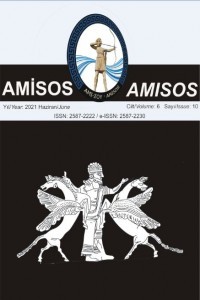KAUNOS´TAN KABARTMALI PITHOS PARÇALARI
2012 – 2014 yılları kazı çalışmalarında Kaunos akropolünde 6 adet kabartmalı pithos parçası ele geçmiștir. Pithoslar büyük boyutlu erzak kapları olup, kabartmalarında geometrik bezemeler içeren örnekler, MÖ 7. ve 6. yüzyılda, bilhassa Karia Bölgesi ve Rodos, Kos ve Girit gibi bölgeye yakın Ege adalarında karșımıza çıkmaktadır. Ele geçen 6 parçadan biri, Kaunos´taki Arkaik iskanın yer aldıǧını düșündüǧümüz akropol batı yamacında, diǧer 5 parça ise yüksek duvarlarla çevrili 152 m yüksekliǧindeki akropol zirvesinin hemen alt bölümünde yer alan AT1 Terası dolgusunda ele geçmiștir. Kaunos akropolünde yapmıș olduǧumuz çalıșmalar akropolün, Kaunos´un erken yerleșiminin önemli bir öğesini oluşturduğunu ve așaǧı șehir sur bölümlerinin inşasından önce, Kaunos sakinlerinin tehlike anında içerisine sığındıǧı bir “sığınak kale” olduğunu ortaya koymuștur. Makalede, konumuzla bağlantılı olarak bugüne kadar Karia ve Rodos´ta ele geçen pithos buluntuları üzerine yapılan araștırmaların bir özeti ile Kaunos pithos parçalarının tarihlendirilmesinin yanı sıra, bir “sıǧınak kale” olarak kullanılmış akropolde ele geçen pithosların Kaunos erken yerleșimi baǧlamındaki işlevi irdelenmektedir.
Anahtar Kelimeler:
Kaunos, Pithos, Sıǧınak Kale, Arkaik, Akropol
FRAGMENTS OF RELIEF PITHOI FROM CAUNUS
During the excavation campaigns 2012-2014 on the Acropolis of Caunus 6 fragments of relief pithoi were discovered. Pithoi were used as large storage vessels in southwestern Asia Minor and on the nearby islands such as Rhodes, Kos or Crete especially in the 7th and 6th century BC. One fragment was found on the western slope of the Acropolis, where we presume at least one part of the archaic settlement of Caunus. The remaining 5 pieces were found in the filling of a terrace located within the fortification wall of the acropolis. This terrace (AT1) lies directly below the 152 m high peak of the acropolis hill. Our previous research on the acropolis revealed that the acropolis is an important element of the early settlement of Caunus. It was a fortified refuge to where the inhabitants could flee in case of an attack before the construction of the lower city walls. The following article suggests not only two options for the function of the relief pithoi on the acropolis, but also explains what consequences the discovery of the fragments could have for the early settlement history of Caunus.
Keywords:
Caunus, Relief Pithoi, Refuge, Archaic, Acropolis,
___
- Anderson, L. H. 1975, Relief Pithoi from the Archaic Period of Greek Art. Colorado.
- Bean G. ve Cook, M. 1952, “The Cnidia” BSA 47, 171-212.
- Berges, D. 2002, “Archaische Funde aus Alt-Knidos” IstMitt 52, 99-164.
- Blinkenberg, C. 1931, Lindos, Fouilles de l'acropole 1902-1914. Berlin.
- Bulba, M. 2009, “Frühe kaunische Keramik – Karisch oder lykisch? ” Adalya 12, 11-27.
- Dümmler, F. 1896, “Pithosfragmante aus Datça” AM 21, 229-236.
- Feytmans, D. 1950, “Les pithoi à reliefs de l'île de Rhodes” BCH 74, 135-180.
- Gürman, O. 1976, “Archaische Plastik im Museum von Bodrum,” AK 19, 81-86.
- Hall, J. F. 1996, Etruscan Italy. Etruscan Influences on the Civilizations of Italy from Antiquity to the Modern Era. Utah.
- Hoepfner, W. 1999, Geschichte des Wohnens 1. 5000 v. Chr.- 500 n. Chr. Stuttgart.
- Jacobi, G. 1929, Scavi nelle necropoli di Jalisso 1924-1928, Clara Rhodos III. Rodos.
- Jacobi, G. 1931, Esplorazione archeologica di Camiro I. Scavi nelle necropoli Camiresi 1929-1930, Clara Rhodos IV. Rodos.
- Karagiorges B. 2002, Early Cyprus. Crossroads of the Mediterranean. Los Angeles.
- Kantzia, C. 1988, “Recent Archaeological Finds from Kos: New Indications for the Site of Kos-Meropis,” Archaeology in the Dodecanese, (Ed. S. Dietz ve I. Papachristodoulou) Kopenhagen: 175–183.
- Kinch, K. F.1914, Fouilles de Vroulia, Rhodes. Berlin.
- Korfmann, M. O. 2006,Troia. Archäologie eines Siedlungshügels und seiner Landschaft. Mainz.
- Metzger, H. 1972, Les céramiques archaïques et classiques de l'acropole lycienne, Fouilles de Xanthos IV. Paris.
- Müller-Wiener, W. 1967, “Panionion und Melie” JDI, 1967, Ergänzungsheft 23, 97-127.
- Özen-Kleine, B.ve Özen, S. 2015, “Neue Forschungen in der antiken Stadt Kaunos” Beiträge des internationalen Symposiums zur Archäologie in der Großregion 7.- 9. März 2014 in Otzenhausen (Ed. M. Koch), Otzenhausen: 67–82.
- Özen, S. ve Özen-Kleine, B. 2019, “2012-13 Kaunos Akropol Kazıları” Karia Arkhaia. La Carie, des origins a le periode pre-hekatomnide, Internationales Symposium in İstanbul 14-16 Oktober 2013 (Ed. K. Konuk/ O. Henry). İstanbul: 201-214. Paoletti, O. 1986, “Una coppa geometrica euboica da Tarquinia” AA 1986, 407-414.
- Salzmann, A. 1875, Nécropole de Camiros: journal des fouilles exécutées dans cette nécrolpole pendant les années 1858 a 1865. Paris.
- ISSN: 2587-2222
- Yayın Aralığı: Yılda 2 Sayı
- Başlangıç: 2016
- Yayıncı: Davut YİĞİTPAŞA
Sayıdaki Diğer Makaleler
ALSANCAK HOCAZADE AHMED RAGIB ÜZÜMCÜ CAMİİ KUBBE YAZISI
O ŞİMDİ BİR CAMİ; PANHAGİA, ANTALYA KESİK MİNARE
Mesut YILMAZ, Serap SEVGİ, Bekir ESKİCİ, Yaşar Selçuk ŞENER, Mevlüt ELİÜŞÜK
PİSİDİA BÖLGESİNDEKİ KARADİĞİN TEPESİNDEN OK VE MIZRAK UÇLARI
Abdulhadi DURUKAN, Ahmet Cuneydi HAS
GÜNÜMÜZE ULAŞAMAMIŞ GELENEKSEL VAN EVLERİNDEN SELAHATTİN SELÇUK EVİ
ÇAKALCA – KARADOĞAN HÖYÜĞÜ KURTARMA KAZISI: AMİSOS’TA MİLETOS KOLONİZASYONUNA DAİR BULUNTULAR
SİBİRYA’DA ÜST PALEOLİTİK ÇAĞ’DA SİMGESEL DAVRANIŞLAR VE TAŞINABİLİR SANAT NESNELERİ
SEYDİŞEHİR ÇEVRESİNDE TESPİT EDİLEN YENİ YERLEŞMELER (2020 YILI YÜZEY ARAŞTIRMALARI KAPSAMINDA)
